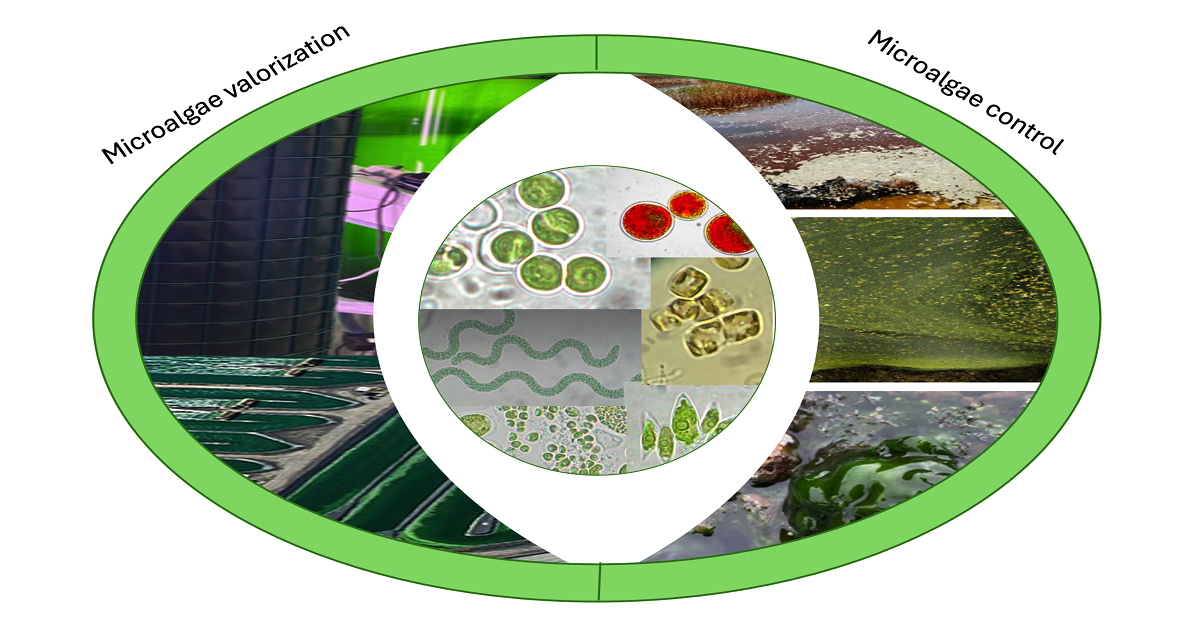Microalgae Control and Utilization: Challenges and Perspectives
A special issue of Water (ISSN 2073-4441). This special issue belongs to the section "Water, Agriculture and Aquaculture".
Deadline for manuscript submissions: 31 July 2025 | Viewed by 4933

Special Issue Editors
Interests: microalgae biology; microalgae biotechnology; photosynthesis; plant cell ultrastructure
Special Issue Information
Dear Colleagues,
Microalgae are photosynthetic microorganisms comprising a very wide variety of both eukaryotic and prokaryotic species that live in all environments, mainly the aquatic ones. Due to their metabolic plasticity, microalgae have attracted great interest for their exploitation in various biotechnological fields, such as phytoremediation, the valorization of organic wastes or by-products, organic farming, or the production of green energy, food/feed, cosmeceuticals, and nutraceuticals. As a result, great attention has been paid to the controlled cultivation of these microorganisms. On the other hand, in natural environments, microalgae can produce blooms, causing eutrophication problems; in addition, cyanobacteria and dinophlagellates especially include harmful species producing toxins. Thus, to prevent environmental hazards that can also affect the health of animals and humans, it is important to develop strategies to control and monitor the growth of dangerous species and/or the occurrence of undesired algal blooms.
This Special Issue aims at gathering scientific contributions (original research articles, short communications, and comprehensive reviews) on microalgae in a broad thematic scenario, emphasizing their implications and future challenges in the context of strong changes in the environment, climate, as well as in society and human habits.
Topics of interest include, but are not limited to, the following:
- Phytoremediation;
- The production of microalgae biomass for food/feed, cosmeceuticals, nutraceuticals, and pharmaceuticals;
- Valorization of waste (by-products and wastes/wastewaters);
- Microalgae cultivation solutions (production and harvesting);
- Algal bloom control;
- Microalgae and the circular economy;
- Microalgae and the SDGs (Sustainable Development Goals);
- The control and/or valorization of harmful microalgae.
Dr. Costanza Baldisserotto
Dr. Tania Mazzuca Sobczuk
Guest Editors
Manuscript Submission Information
Manuscripts should be submitted online at www.mdpi.com by registering and logging in to this website. Once you are registered, click here to go to the submission form. Manuscripts can be submitted until the deadline. All submissions that pass pre-check are peer-reviewed. Accepted papers will be published continuously in the journal (as soon as accepted) and will be listed together on the special issue website. Research articles, review articles as well as short communications are invited. For planned papers, a title and short abstract (about 100 words) can be sent to the Editorial Office for announcement on this website.
Submitted manuscripts should not have been published previously, nor be under consideration for publication elsewhere (except conference proceedings papers). All manuscripts are thoroughly refereed through a single-blind peer-review process. A guide for authors and other relevant information for submission of manuscripts is available on the Instructions for Authors page. Water is an international peer-reviewed open access semimonthly journal published by MDPI.
Please visit the Instructions for Authors page before submitting a manuscript. The Article Processing Charge (APC) for publication in this open access journal is 2600 CHF (Swiss Francs). Submitted papers should be well formatted and use good English. Authors may use MDPI's English editing service prior to publication or during author revisions.
Keywords
- microalgae
- cultivation of microalgae
- phytoremediation
- wastewaters
- algal bloom
- microalgal toxins
Benefits of Publishing in a Special Issue
- Ease of navigation: Grouping papers by topic helps scholars navigate broad scope journals more efficiently.
- Greater discoverability: Special Issues support the reach and impact of scientific research. Articles in Special Issues are more discoverable and cited more frequently.
- Expansion of research network: Special Issues facilitate connections among authors, fostering scientific collaborations.
- External promotion: Articles in Special Issues are often promoted through the journal's social media, increasing their visibility.
- e-Book format: Special Issues with more than 10 articles can be published as dedicated e-books, ensuring wide and rapid dissemination.
Further information on MDPI's Special Issue policies can be found here.






